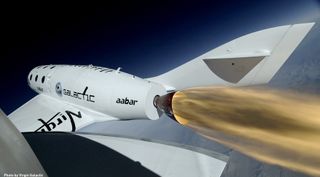SpaceShipTwo Bounces Back to Rubber Fuel

LAS CRUCES, N.M. — Virgin Galactic is planning to return to a rubber-like fuel when it resumes powered test flights of its SpaceShipTwo suborbital vehicle based on the results of an ongoing series of tests of the spacecraft's hybrid rocket motor.
Virgin Galactic Chief Executive George Whitesides, speaking at the International Symposium for Personal and Commercial Spaceflight here Oct. 8, said the company had carried out a series of full-duration test firings of the motor recently, which used a rubber-like fuel formally known as hydroxyl-terminated polybutadiene (HTPB).
"I'm pleased to say that we have had really terrific progress" on the vehicle's propulsion system, he said while showing videos of two recent engine tests, each running about 60 seconds. "We have good combustion quality on these firings." [How Will Virgin Galactic Return to Flight?]
Virgin Galactic originally planned to use HTPB fuel for the rocket motor, which also uses liquid nitrous oxide propellant. However, in May 2014, the company announced it was switching to a polyamide fuel, similar to nylon, citing improved performance.
That nylon-fuel motor was flown on SpaceShipTwo's last test flight in October 2014, when the vehicle broke apart seconds after engine ignition. An investigation led by the National Transportation Safety Board concluded in July that pilot error in prematurely unlocking the vehicle's feathering system caused the crash, and the motor was not implicated in the accident.
Whitesides did not state at the conference if the rubber or nylon fuel would be used when powered test flights of a second SpaceShipTwo vehicle resumed. However, another company executive, Will Pomerantz, said earlier this year that the company had an "internal horse race" between the two motors, and would fly the one that is the best.
In an Oct. 14 email, Whitesides said that the current design of the rocket motor "baselines" the use of HTPB fuel, a decision that will be finalized after a series of qualification, or "qual," tests. "We're focused on qual of that system now, and assuming qual is completed according to plan, we will use that configuration to resume powered test flights," he wrote.
Get the Space.com Newsletter
Breaking space news, the latest updates on rocket launches, skywatching events and more!
Whitesides said at the conference that Virgin Galactic was making progress completing the second SpaceShipTwo vehicle. Recent milestones in the vehicle's development included a fit check of the oxidizer tank for its propulsion system inside the vehicle and new seats for the pilots in the cabin.
The second SpaceShipTwo is very similar to the first, Whitesides said, since the overall design of the vehicle did not figure into the accident. "The airframe itself, we think, is sound. The propulsion system is sound," he said. "We required very few changes to the vehicle following our test flight accident."
Whitesides declined to give a schedule for when test flights would resume, saying he didn't want to put schedule pressure on the team building the vehicle. "We'll resume flights when we're ready to do so," he said. "We're getting very close now, making great progress. But I don't want to put undue pressure on them by giving them an artificial timeline."
The second SpaceShipTwo will go through a test program similar to the first, including a series of "captive carry" flights where it remains attached to its WhiteKnightTwo aircraft, unpowered glide flights, and powered tests. However, there may be fewer test flights, Whitesides said, based on the experience from the original test program.
"Instead of doing five or ten tests to gradually inch up on a particular test point, we'll be able to get there in maybe two flights or three flights," he said. "That means we should move quicker than the first cycle of the test flight program."
Whitesides said that Virgin Galactic, which now has more than 500 employees working on both SpaceShipTwo and its LauncherOne small satellite launch vehicle, has rebounded from last year's crash that killed co-pilot Michael Alsbury and injured pilot Peter Siebold. "The accident was a tough blow for Galactic, but it was one that will not define the company," he said. "It is one that we must move past and that we are moving past with determination and with spirit."
This story was provided by SpaceNews, dedicated to covering all aspects of the space industry.
Join our Space Forums to keep talking space on the latest missions, night sky and more! And if you have a news tip, correction or comment, let us know at: community@space.com.

Jeff Foust is a Senior Staff Writer at SpaceNews, a space industry news magazine and website, where he writes about space policy, commercial spaceflight and other aerospace industry topics. Jeff has a Ph.D. in planetary sciences from the Massachusetts Institute of Technology and earned a bachelor's degree in geophysics and planetary science from the California Institute of Technology. You can see Jeff's latest projects by following him on Twitter.

